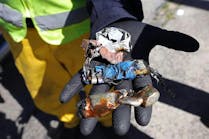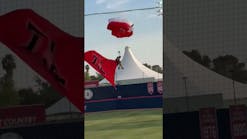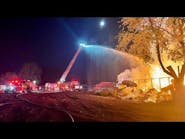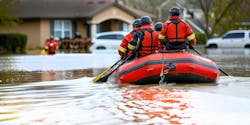Over the last few years we have seen it time and again regarding the injuries and deaths to firefighters on the training ground regarding live burns. They involve individuals from the rookie to the seasoned veteran and the cause of these injuries and deaths are related to several factors and consistent repetitive mistakes.
Training fires can be even more hazardous then actual structure fires. Over the last few years we have seen it time and again regarding the injuries and deaths to firefighters on the training ground regarding live burns. They involve individuals from the rookie to the seasoned veteran and the cause of these injuries and deaths are related to several factors and consistent repetitive mistakes. Lives burns are a invaluable experience in educating a firefighter's attitude and skills when involved in fire suppression activities. When you can experience heat, smoke and flame fronts in a training environment you have given the firefighter a dose of reality for the real deal. Unfortunately these experiences using acquired structures and real fires provide many inherent risks. The tragedies that can happen at a real fire can definitely happen at your acquired structure training fire. A repetitive history of departments failing in the areas of basic safety, procedures and precautions have been increasingly documented. With NFPA 1403 we can limit the risks associated with this type of training. It is very important for training officers and instructors involved in live fire training exercises to be thoroughly versed in this minimum standard that applies to the areas of acquired structures.
There has been a steady decline of actual fires as we all know over the past twenty years. But what has also declined drastically is the ability for fire departments to be able to conduct live fire training due to several factors of red tape, EPA approval, permits, contractors, home owners and a host of paperwork that needs to be done before an actual training fire can even be conducted. Finding appropriate facilities for structural live fire training can be very difficult and almost next to impossible. The main purpose and function of live fire training whether it is conducted in an acquired structure or burn building is to provide a solid quality of training in the fire experience. Training toward realism while incorporating the right skills and competencies for firefighters in order to increase fire ground safety and understanding is a clear objective. This is an excellent way in dealing with the real world responses in structural firefighting.
The relationship of a burn building or fire tower and an actual acquired structure is entirely two different animals. One is of relative concrete construction which allows for better controlled fire behavior while the other can be totally unpredictable if not prepared and planned for in the right way. The burning of an acquired structure for the purposes of conducting live fire training is a very serious matter and should not be taken lightly or gone into without understanding the risks involved. The acquired structure delivers some extreme realities in experiencing the heat, smoke and combat of fighting fires. If you don't understand fire behavior along with building construction you have no business conducting these events. There's a safe way to train and a wrong way when it comes to live fire training. In order to train firefighters and allow them the experience of live fire we must be able to minimize the potential for injury and even death.
NFPA 1403 Standards
With the enactment of NFPA 1403 we at least have a document or plan that provides us the minimum requirements for training our members under live fire conditions. Basically NFPA 1430 sets up a plan or a process and provides a checklist of conducted behaviors involving a safe approach to this type of training as well as minimizing certain risks. A good way to look at NFPA 1403 while using its guidelines for live fire training is to help you and your involvement within acquired structures to be safe and sensible. NFPA 1403 provides guidelines for both acquired structures involving interior live burns as well as fires conducted in fire buildings involving the burning of natural combustibles and also natural gas/propane fired training structures.
Even with NFPA 1403 a growing number of departments have diminished or even completely eliminated the use of acquired structures for live fire training. There are many reasons why this is happening but include the areas of liability in firefighter injuries and deaths that have occurred over the past several years. Once you have your structure you need to be able to provide the highest levels of safety along with thorough and appropriate planning as well as making sure that a good incident command system is provided for.
Now that you have your structure and your paperwork's complete you can begin thinking about a live fire exercise and planning for it properly. Remember that you are creating a real dynamic environment that can cause extreme hazards and risks to interior firefighters and firefighting suppression efforts. What should be upper most in your mind is the ability to provide great care in safety and an extremely supervised event. Safety has to be the ultimate priority and consideration. In order to help you stick to that priority you should utilize NFPA 1403 to keep you on track. Remember there is a big difference between fire in acquired structures and training in fires in a burn building. First the acquired structure will give you a limited amount of burns. It will also give you similar fires but they can become quite different depending upon the involvement of the structure. Whereas conducting fires in a burn building specifically designed for repetitive fires allows for many evolutions to be conducted without the probability of extension into its structure.
Some of the important challenges relating to live fire training deals with the experience of officers and firefighters involved in the exercises. It is very important that training officers and the instructors involved in live fire training realize that most experiences of real fire related behavior has increasingly been diminished or the last 20 years. Many of the experienced firefighters and officers have been leaving the fire service over the past few years leaving young officers with little experience making way for the inability to recognize simple fire behavior principles such as flashover and potential building collapse. They also may not have the inability to react quickly enough to avoid additional certain potentially fatal conditions when conducting live fire exercises.
Another important feature of acquired structures for life fire training is the type of structure usually provided for the event. Most of the time it is an older home as well as being a smaller home in comparison to the type of construction that are all around us today. It is very rare that a fire department will be able to acquire larger and newer home types of structures involving increased square footage as well as different types of construction features and fuel loads.
Conducting The Training
Regardless whether the structure is fixed or acquired there are certain requirements during live fire training that should be adhered to. One very important area involves the individuals participating in this type of training. Live fire training with those involved should at least have a firm basic operational skill level in fire suppression in order to participate. They should also have a firm basis of safety skills as they relate to actions and tasks on the fireground in order to prevent creating inherent safety problems to others as well as to themselves.
Those conducting the training should also have a clear and operative understanding regarding an incident management system with an instructor in charge who will be inevitably the operational command of the training exercise. This along with the required number of additional instructors must be insured in order to operate in the dynamics of life fire training.
If you are conducting a multi-company operation meaning that different functions are going on simultaneously such as fire suppression and roof operations you should allow for one instructor for each operation. Another way to look at this is to provide an instructor for the appropriate span of control of 5 to 7 members involved. Another important feature of multi-company operations is also the use of scenarios that involve multiple hose lines. Here it is a good idea to have an instructor overseeing each line involved in the suppression effort during the training event. It is important to note that when conducting scenarios involving more than one hose line at training fires that the appropriate amount of personnel to move a dedicated size line be present when operating on that line.
One of the biggest and important realizations when conducting live fire training is that you must never use a live victim in the role of a civilian or a downed firefighter in full protective clothing. Many injuries and even a few deaths have occurred during training exercises in what instructors thought provided more realism only to experience the ultimate tragedy.
Any house or structure that has been acquired for live fire training should be thoroughly examined before the lighting of the first flare into order to insure that there are no individuals such as homeless, vagrants or animals in the structure.
Preparing Participants
When companies arrive for training involving live fire a thorough briefing should be provided. During this briefing it is important that all aspects of the training, problems and their solutions are being thoroughly discussed. That all instructions are understood in regards to the expectations and the assignments that need to be covered. This along with a pre-burn look at the interior of the building by allowing all members to walk through it must be done. Even though this type of behavior would never be offered to us as firefighters when responding to a given structure involved in fire. It is extremely important to allow those involved in live fire training to safely see and plan their operations within the structure before it is being attacked by fire. The instructors conducting the training should never conceal the burn room or where they intend to light the fire within the structure. It is of utmost importance that the walk through the structure allows the participants to see this room in order to formulate probable fire behavior and what they may be exposed to or confronted with during fire suppression efforts. It will never be the same building once it is filled with heat and smoke, but the participants in knowing the layout will be able to allow and plan for expected fire behavior in zero visibility which provides for an increase in safety.
The preparation of the participants is extremely important especially in verifying the level of training and experience that each member has. All members participating in a live fire training exercise should be observed to be in good health and physical condition. All participants should have an understanding of the incident command system as well as having an accountability procedure in place. A thorough review of the accountability system being used as well as emergency evacuation signals being used should be clearly understood by all participants. All areas of safety should be addressed including who is the safety officer and who is in charge. Make sure that it is understood that the safety officer has the ultimate authority to stop any activity or evolution at any time.
Another important feature when conducting live fire training is those instructors and those in charge should ensure that all participants are wearing the proper protective clothing. That all SCBA's and their safety alert systems are functioning properly. All instructors as well as all participants should check and review each other in order to make sure that there are no problems with equipment or exposures of skin regarding protective clothing. All SBA's should have the proper amount of air within them.
Ignition Of A Fire
When everyone is ready and a decision is made to light the fire it is important for all instructors to know that the area has been cleared of personnel and that all members are in their proper positions with the understanding of their assignments. Maintaining an instructor in charge who is responsible for the overall operation that is being conducted should be clearly acknowledged by everyone participating in the exercise. There should never be more than one person in charge as well as their never being more than one person in charge of igniting the fire. It is sometimes best to assign one of the instructors as the ignition firefighter who operates under the command of the person in charge. Any decision to ignite the fire will be authorized by the instructor in charge as well as the ignition firefighter being the only one authorized to light the fire itself. There will also never be multiple fires started within the structure. A room and contents fire meaning the fuel load of natural woods and straw will only occur in one room at a time. Multiple rooms should never be lit. No fires should be lit in the areas or paths of egress that would be needed to evacuate the building. It is important for all instructors as well as the person in charge to discuss with all participants a plan for emergency evacuations including evacuation signals or communications.
Fuels that are used during live fire training should have predictable burning characteristics consistent of class "A" combustibles. Debris found within the structure that is not of this consistency should be cleared away out of the structure. There are some fuels such as woods that are treated with chemicals such as pressurized woods, rubber products, plastics of all types and flammable combustible liquids are all never to be used in training fires.
Who's In Charge
Another important feature that should be present at all live fire training in acquired structures should be the presence and appointment of a safety officer. The safety officer is not the same person that would be in charge or have overall command of the operation. This person should have a good knowledge base in the areas of fire behavior and fire suppression activities regardless of his rank. He holds and has the ultimate authority to shut down activities involved in the fire training evolution at any time due to an unsafe condition or situation.
Pre-Planning Strategies
Safety concerns involving live fire training should not only be conducted during the training event but should have been a major portion in the preplanning strategies when setting up the structure and the training evolutions for live fire training exercises. How can we be sure that an acquired structure has been safely and appropriately prepared for live fire training exercises? Let's highlight some of the important areas when preparing an acquired structure for live fire training. It is obvious that a complete inspection of the property be conducted to insure that a basic integrity of the structure itself is present. All hazardous materials found or stored within the walls or on the premises should be removed. Any containers that may be found that are assembled in such away as to provide for the allowance of building pressure under heat conditions causing them to become projectile missiles or explosives should be removed.
Roof conditions should thoroughly be examined for their integrity as well as any chimney stacks that may have the potential to collapse should also be considered for removal. Any areas on the interior of the structure that will provide for unwanted fire extension and travel such as holes in walls and ceilings should be covered. Any large objects or increased weight bearing areas should be removed or reinforced in order to avoid collapse especially in the areas above the fire training that is to be conducted. Sometimes it's a good idea to even remove bathtubs on second and third floors depending upon where their relationship is to the areas of fire training or rooms of ignition.
Operations And Activities
During all live fire training exercises another important feature to remember when conducting multi-company tasks is to avoid allowing companies to engage in activities above the fire area except in the case of roof operations. Serious injuries and deaths have occurred in rooms and areas above a live fire training exercise. In order to avoid many of these situations good preplanning involving and providing for adequate ventilation openings should be created predominantly in the roof areas of the structure. This will allow for the escape of heat and toxic smoke as well as any other explosive type gases.
Additionally all participants should be briefed on the proper hose line advancement techniques as they relate to the nozzleman, backup man, turn or door man and officer. Members on the hose line should review and check the nozzles patterned position and flow before entering structure. Participants entering a structure under live fire conditions will be in a crawling position with the hose line and nozzle between the participants and the fire at all times. The interior live fire instructors along with the acting company officer will supply the direction to the nozzleman regarding application of water to the fire. This will avoid a complete knock down or extinguishment of the fire area in order to continue repetitive live burns in the same room or area. All members on the hose line should be accounted for after the knock down of the fire and then retreat from the building with the hose line making sure to stay low. After all participants are outside of the structure another accountability check should be conducted and to make certain that there are no minor injuries.
When conducting live fire training in acquired structures instructors should be sure to establish at least 3 hose lines in a ready position before ignition of the fire and entry of participants into the structure. One hose line will be used by the participants advancing and attacking the fire while an additional hose line will be placed for the purposes of a backup crew and a final third to be used as a safety line kept in the burn area.
Ventilation activities will ultimately be provided and controled by the instructors making sure that ventilation is occurring continuously in order to avoid buildup of extreme heat and gases. Ventilation activities should also occur during water application on the fire in order to lift smoke and steam away from the attack crew.
In summary conducting a safe live fire training exercise in an acquired structure it is imperative that the preparation of the training site, the students or participants along with safety briefings be provided with everyone paying strict attention in what is to be expected regarding the evolutions.
During the preplanning of the live fire training exercise it is a good idea to mark all egress areas with brightly colored paints. Make certain that all utilities have been disconnected. If you can't make the building safe and adhere to NFPA 1403 than take into consideration that it may be best not to use it.
Related:
- NY Firefighter Killed In Fire Training Exercise
- NIOSH Reports on Lairdsville, NY Training Tragedy
- One Year Later: Lessons Learned from Lairdsville
- Harry Carter Commentary Live Fire Training -- Do It By The Book
- This is the Front Desk ... With Your WAKE-UP Call!
Lieutenant Mike Mason is a 23 year veteran of the fire service and currently assigned to Downers Grove, IL, Fire Department Engine Co. 3 and heads the high rise districts and its policies for his department and all responding area departments. He is a Certified Instructor III and Fire Officer II along with being a staff instructor for the Downers Grove Fire Academy and other academies throughout the state of Illinois. He is the author of R.I.C.O., Rapid Intervention Company Operations which is recognized as the largest and most comprehensive text available on Rapid Intervention. It is respected and used by many instructors from all over the country including some organizations overseas for its content and applicability in all areas of firefighter rescue. Lt. Mason has also originated the national program entitled R.I.C.O.tm (Rapid Intervention Company Operations) which utilizes an ever changing program involving the most up to date progressive procedures, maneuvers and techniques which are taught by some of the most prominent instructors in firefighter rescue from across the nation. Lieutenant Mike Mason can be reached at [email protected]





